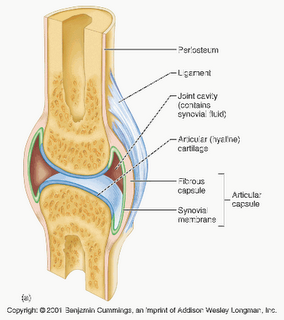When the oil light comes on, it’s time to stop the car and call the tow truck. Driving without the proper amount of oil lubricating the engine means the car will soon shut down and repairs will probably be expensive. Unfortunately, we don’t have our own set of dashboard lights (where would they go?) to warn when vital fluids are low or cold or sluggish, but you get the message soon enough when you try to move or stretch without proper lubrication. I want to talk about joints a little bit today…synovial joints. I want to talk about the connections between the various long bones in your appendages and the joints that allow you range of motion in your arms, legs, hips and shoulders. These hinges are key points in your mobility and keeping them flexible and healthy are important, especially as you age, so you can continue to reach up and bend over in your daily activities.
I want to talk about joints a little bit today…synovial joints. I want to talk about the connections between the various long bones in your appendages and the joints that allow you range of motion in your arms, legs, hips and shoulders. These hinges are key points in your mobility and keeping them flexible and healthy are important, especially as you age, so you can continue to reach up and bend over in your daily activities.
The diagram shows how these joints are constructed. The ends of the bones, connected by ligaments, are covered in a layer of cartilage to prevent wear and tear on the bones themselves. The joint is contained in a housing of synovial membrane that secretes the “oil” of the joint, called synovial fluid. This fluid is essential to the health of the joint; too little and the bones grind against each other and wear off the cartilage, too much from inflammation (or foreign material like pus or blood) can cause the joint to swell painfully. Even the natural settling of the fluid from non-use overnight can make you stiff until you start moving again in the morning.
For the most part, keeping your joints healthy and your fluids flowing is as simple as regular use (some forms of arthritis and other injuries heal with rest rather than use, so make sure your doctor approves of your regimen). One of the reasons yoga is such a great part of your routine is that is requires extensive work from all joints; you bend and flex in many directions that you wouldn’t during regular use, so the synovial fluid washes over all parts of the joint and is kept warm and moving. Various studies have demonstrated how exercise is beneficial to the overall health of these important hinges—although, if you are a regular practitioner of yoga you already know this.
During your next yoga sequence, pay special attention to the work and range of motion in your joints. Notice the directions they bend easily and be aware (and careful) of the ways the movement is more difficult. Whether bending forward in Uttanasana (Intense Forward Bend); extending the legs to the side in Trikonasana (Triangle); crossing the legs in Garudasana (Eagle); or extending back in Virabhasdrasana I (Warrior 1), you can’t help but marvel at the engineering of these hinges…and that’s just the hips. So be kind to them, use them regularly, and don’t bend them in the wrong direction. Here’s looking at you (and your joints), kid!
©Brenda K. Plakans. All Rights Reserved
 I want to talk about joints a little bit today…synovial joints. I want to talk about the connections between the various long bones in your appendages and the joints that allow you range of motion in your arms, legs, hips and shoulders. These hinges are key points in your mobility and keeping them flexible and healthy are important, especially as you age, so you can continue to reach up and bend over in your daily activities.
I want to talk about joints a little bit today…synovial joints. I want to talk about the connections between the various long bones in your appendages and the joints that allow you range of motion in your arms, legs, hips and shoulders. These hinges are key points in your mobility and keeping them flexible and healthy are important, especially as you age, so you can continue to reach up and bend over in your daily activities. 
No comments:
Post a Comment